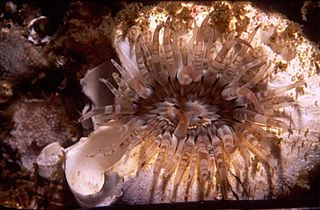
Eunicella verrucosa, the broad sea fan, pink sea fan or warty gorgonian, is a species of colonial Gorgonian "soft coral" in the family Gorgoniidae. It is native to the north-eastern Atlantic Ocean and the western Mediterranean Sea.

Simnia spelta is a species of sea snail, a marine gastropod mollusc in the family Ovulidae, the ovulids, which are cowrie allies sometimes called "false cowries". It was first described in 1758 by the Swedish naturalist Carl Linnaeus.

Haliclona anonyma, the turret sponge or tubular fan sponge, is a species of demosponge. It is endemic to South Africa, where it occurs between the Cape Peninsula and Sodwana Bay.

The walking anemone, also known as the hedgehog anemone or sock anemone, is a species of sea anemones in the order Actiniaria. It is the only member of its genus, Preactis.

The multicoloured sea fan is a species of gorgonian sea fan in the family Melithaeidae.

The ring-tentacle anemone is a species of sea anemone in the family Isanthidae.

The Cape zoanthid is a species of zoanthid in the family Parazoanthidae.

The purple soft coral is a species of colonial soft coral in the family Alcyoniidae.
The Valdivian soft coral is a species of colonial leathery or soft coral in the family Alcyoniidae.

The variable soft coral is a species of colonial soft coral in the family Alcyoniidae.

The sun-burst soft coral is a species of colonial soft corals in the family Malacacanthidae. It is the only species known in the genus Malacacanthus.

The cauliflower soft coral is a species of colonial soft coral in the family Nephtheidae.

The gorgonian twig coral is a species of gorgonian sea fan in the family Anthothelidae.

The whip fan, also called the flagellar sea fan, is a species of gorgonian sea fan in the family Eunicellidae.

The sinuous sea fan is a species of gorgonian sea fan in the family Gorgoniidae.

The palmate sea fan is a species of gorgonian sea fan in the family Gorgoniidae.

The pink hermit crab is a species of hermit crab in the family Diogenidae.

Thuiaria articulata, the jointed hydroid or sea spleenwort, is a branching colonial hydroid in the family Sertulariidae.
Swiftia pallida is a species of gorgonian-type octocoral in the family Plexauridae sometimes known as the northern sea fan. At one time it was considered to be a subspecies of Swiftia rosea.

Astrocladus euryale, the basket star, or gorgon's head is a brittlestar of the family Gorgonocephalidae found in the coastal waters of South Africa from the west coast of the Cape Peninsula to about Algoa Bay.



















